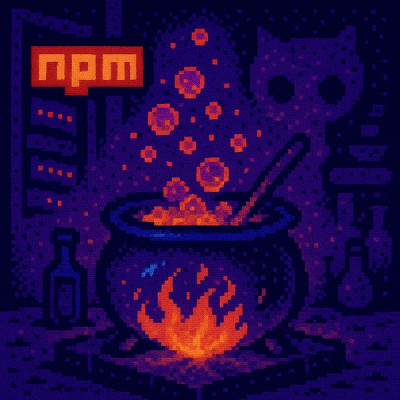
Security News
How Enterprise Security Is Adapting to AI-Accelerated Threats
Socket CTO Ahmad Nassri discusses why supply chain attacks now target developer machines and what AI means for the future of enterprise security.
@elisiondesign/v-runtime-template
Advanced tools
Create Vue components by compiling templates on the fly
A Vue.js components that makes easy compiling and interpreting a Vue.js template at runtime by using a v-html like API.
Do you know VueDose? It's where you can learn tips about the Vue.js ecosystem in a concise format, perfect for busy devs! 🦄
This library solves the case where you get a vue-syntax template string on runtime, usually from a server. Think of a feature where you allow the user to create their own interfaces and structures. You save that as a vue template in your database, which your UI will request later. While components are pre-compiled at build time, this case isn't (since the template is received at runtime) and needs to be compiled at runtime.
v-runtime-template compiles that template and attaches it to the scope of the component that uses it, so it has access to its data, props, methods and computed properties.
Think of it as the v-html equivalent that also understands vue template syntax (while v-html is just for plain HTML).
Install it:
npm install v-runtime-template
You must use the with-compiler Vue.js version. This is needed in order to compile on-the-fly Vue.js templates. For that, you can set a webpack alias for vue to the vue/dist/vue.common file.
For example, if you use the Vue CLI, create or modify the vue.config.js file adding the following alias:
// vue.config.js
module.exports = {
runtimeCompiler: true
};
And in Nuxt, open the nuxt.config.js file and extend the webpack config by adding the following line to the extend key:
// nuxt.config.js
{
build: {
extend(config, { isDev, isClient }) {
config.resolve.alias["vue"] = "vue/dist/vue.common";
// ...
You just need to import the v-runtime-template component, and pass the template you want:
<template>
<div>
<v-runtime-template :template="template"></v-runtime-template>
</div>
</template>
<script>
import VRuntimeTemplate from "v-runtime-template";
import AppMessage from "./AppMessage";
export default {
data: () => ({
name: "Mellow",
template: `
<app-message>Hello {{ name }}!</app-message>
`
}),
components: {
AppMessage,
VRuntimeTemplate
}
};
</script>
The template you pass have access to the parent component instance. For example, in the last example we're using the AppMessage component and accessing the {{ name }} state variable.
But you can access computed properties and methods as well from the template:
export default {
data: () => ({
name: "Mellow",
template: `
<div>
<app-message>Hello {{ name }}!</app-message>
<button @click="sayHi">Say Hi!</button>
<p>{{ someComputed }}</p>
</div>
`,
}),
computed: {
someComputed() {
return "Wow, I'm computed";
},
},
methods: {
sayHi() {
console.log("Hi");
},
},
};
Keep in mind that the template can only access the instance properties of the component who is using it. Read this issue for more information.
TL;DR: If you need to interpret only HTML, use v-html. Use this library otherwise.
They both have the same goal: to interpret and attach a piece of structure to a scope at runtime. The difference is, [v-html](https://vuejs.org/v2/api/#v-html) doesn't understand vue template syntax, but only HTML. So, while this code works:
<template>
<div v-html="template"></div>
</template>
<script>
export default {
data: () => ({
template: `
<a href="/mike-page">Go to Mike page</a>
`
the following wouldn't since it uses the custom router-link component:
<router-link to="mike-page">Go to Mike page</router-link>
But you can use v-runtime-template, which uses basically the same API than v-html:
<template>
<v-runtime-template :template="template"></v-runtime-template>
</template>
<script>
export default {
data: () => ({
template: `
<router-link to="mike-page">Go to Mike page</router-link>
`
<component>)Dynamic components have somewhat different goal: to render a component dynamically by binding it to the is prop. Although, these components are usually pre-compiled. However, the goal of v-runtime-template can be achieved just by using the component options object form of dynamic components.
In fact, v-runtime-template uses that under the hood (in the render function form) along with other common tasks to achieve its goal.
FAQs
Create Vue components by compiling templates on the fly
We found that @elisiondesign/v-runtime-template demonstrated a not healthy version release cadence and project activity because the last version was released a year ago. It has 2 open source maintainers collaborating on the project.
Did you know?

Socket for GitHub automatically highlights issues in each pull request and monitors the health of all your open source dependencies. Discover the contents of your packages and block harmful activity before you install or update your dependencies.

Security News
Socket CTO Ahmad Nassri discusses why supply chain attacks now target developer machines and what AI means for the future of enterprise security.

Security News
Learn the essential steps every developer should take to stay secure on npm and reduce exposure to supply chain attacks.

Security News
Experts push back on new claims about AI-driven ransomware, warning that hype and sponsored research are distorting how the threat is understood.